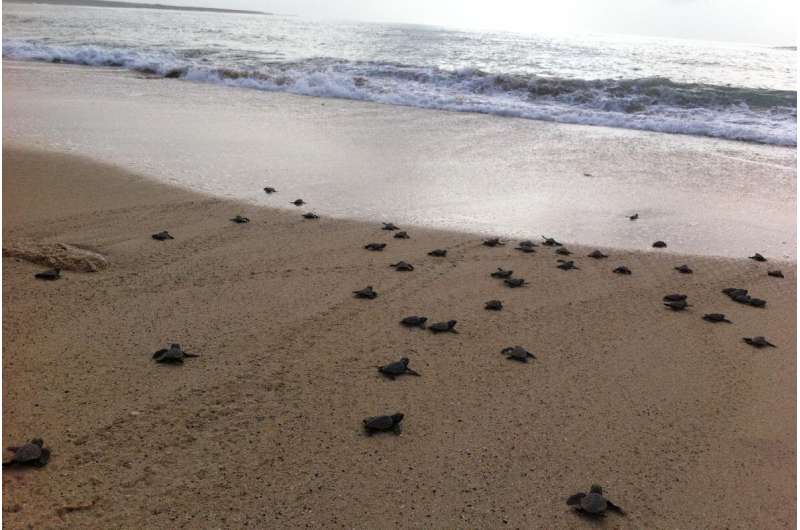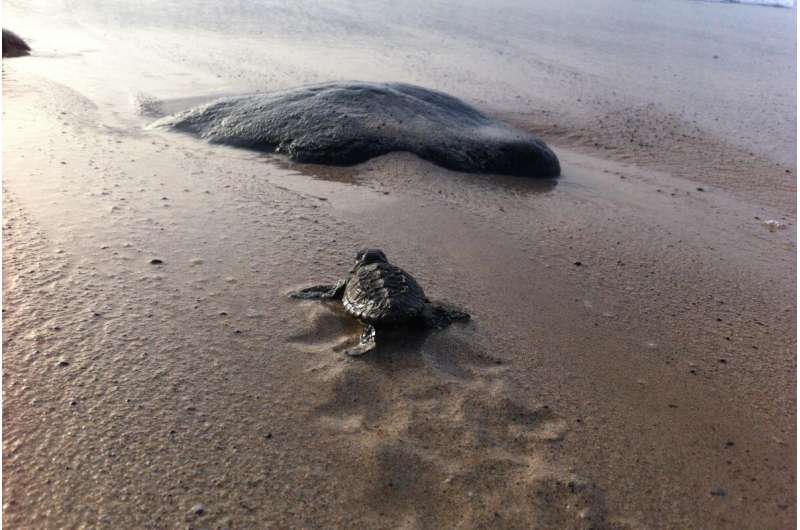Mitigating the impact of climate change on sea turtle hatchling sex ratios does not have to cost the earth

The sex of sea turtle hatchlings is determined by the temperature when the eggs incubate. A higher temperature produces more females, with males produced by lower temperatures.
The increase in sea temperatures is leading to more female sea turtles. Some populations are showing up to a 90% bias towards female hatchlings, with potential impacts for population viability. High sand temperatures also cause reduced hatching success.
The study, published in the Journal of Applied Ecology, shows the potential for two interventions to reduce nest incubation temperatures and stabilize sex ratios in a nesting loggerhead turtle population in the Eastern Atlantic Ocean.
Dr. Leo Clarke, marine biologist at Bangor University and lead author of the study explained:
"Previous work has tested various techniques to reduce nesting temperatures in sea turtles, including sprinkling and shading of the nests and moving eggs to labs for incubation
"However many of these techniques require significant resource and manpower. Turtle nesting sites or 'rookeries' are often in remote locations and ideal solutions need to be simple and cheap.
"We tested two interventions: nest shading, and a new technique that we call nest "splitting." This involved halving the number of eggs in a nest, hopefully reducing the amount of metabolic heat that the eggs generate as they incubate and reducing temperatures."
Both techniques reduced nest temperatures compared to natural nests. Shaded nests were on average 1.1°C cooler and split nests were 0.5°C cooler, resulting in hatchling sex ratios that were 1.5% female and 45% female, compared to 69% females produced in natural nests.
Importantly, neither technique affected the fitness of the hatchlings, which can also be affected by nest temperatures.

Hatchlings need to be able to avoid predators
"We measured all sorts of elements related to the hatchlings," said Dr. Clarke, "including their size, weight, running speed and how fast they could right themselves, and importantly found no difference between the nests. These are really important, as hatchlings need to be able to avoid predators on the beach and when they make it to the sea."
The study was carried out in Cape Verde, West Africa, the third largest loggerhead turtle nesting site . The team relocated eggs from nesting females to a beachside hatchery where they carried out the experiment.
"We would walk all night up and down the beaches and take eggs for our experiment from females as they nested."
The results give hope that simple management can help protect endangered sea turtle populations in a changing climate.
The researchers believe that the techniques will be effective elsewhere.
"Most sea turtle populations lay large numbers of eggs, sometimes 150 or more, and produce a significant amount of metabolic heat, so we expect that splitting the nest will work in other areas and for other species and populations," said Dr. Clarke.
"Wildlife watching tourism, including sea turtles, generates significant amounts of revenue in areas with nesting populations, and sea turtles also graze on algae and seagrass and maintain healthy coral reef ecosystems. So conserving healthy populations in the future is really important."
The paper, "Low‐cost tools mitigate climate change during reproduction in an endangered marine ectotherm," is available via open access in the Journal of Applied Ecology.
More information: Leo J. Clarke et al. Low‐cost tools mitigate climate change during reproduction in an endangered marine ectotherm, Journal of Applied Ecology (2021). DOI: 10.1111/1365-2664.13874
Journal information: Journal of Applied Ecology
Provided by Bangor University





















